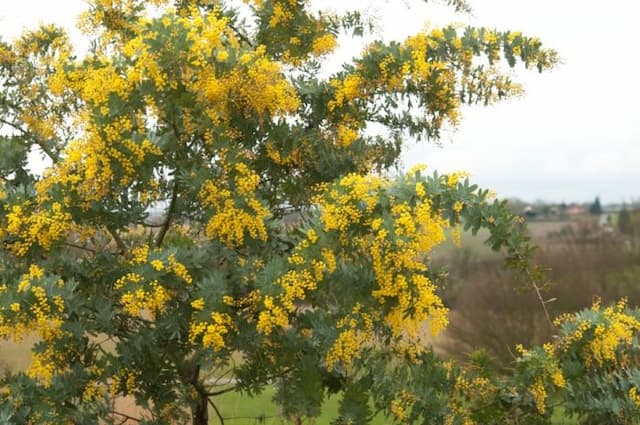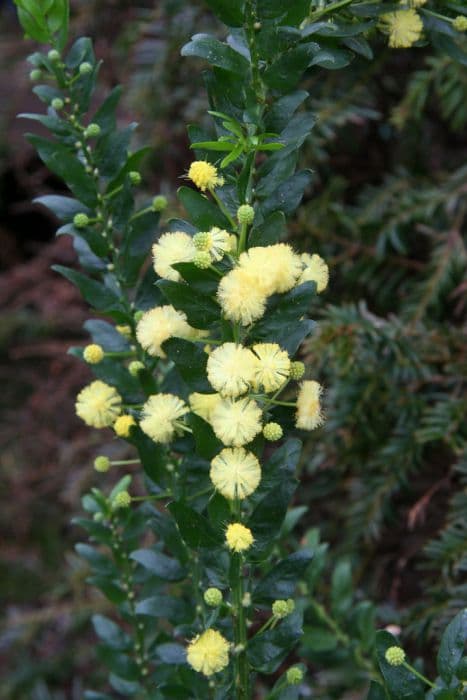Silver Senna Senna artemisioides

ABOUT
Senna artemisioides, commonly known as Feathery Cassia, is a visually appealing plant with a distinct appearance. The plant is characterized by its fine feathery leaves that resemble those of the artemisia plants, hence the name. The leaves are compound with small, multiple leaflets that are gray-green, providing a soft, delicate texture to the foliage. Throughout various seasons, Feathery Cassia blooms with bright yellow flowers that are small and typically grouped in clusters. These flowers stand out against the foliage and can add a splash of color to the plant's surroundings. The plant also produces seed pods that are flat and elongated, turning brown as they mature. The overall visual effect of Feathery Cassia is one that is both graceful and vibrant, making it a popular choice for ornamental purposes in suitable climates.
About this plant
 Names
NamesFamily
Fabaceae
Synonyms
Feathery Cassia, Silver Cassia, Silver Senna, Feathered Senna, Desert Cassia, Wormwood Senna
Common names
Cassia artemisioides, Cassia eremophila, Cassia artemisioides var. sturtii, Cassia artemisioides var. oligophylla, Cassia artemisioides var. helmsii, Senna artemisioides var. sturtii, Senna artemisioides var. oligophylla, Senna artemisioides var. helmsii.
 Toxicity
ToxicityTo humans
The plant known as Feathery Cassia (Senna artemisioides) is not well-documented for its toxicity to humans, which could indicate that it is not highly toxic or that any cases of poisoning are rare or not well-reported. However, plants in the Senna genus have been known to contain compounds like anthraquinones which can have a laxative effect. Ingesting parts of the plant may lead to gastrointestinal upsets such as cramps and diarrhea. It is always prudent to exercise caution and avoid eating parts of ornamental plants due to potential adverse reactions.
To pets
Feathery Cassia (Senna artemisioides) has not been reported as a common toxic plant to pets such as dogs and cats. However, as with humans, plants in the Senna genus may contain compounds that could have a laxative effect. Ingestion can potentially cause mild gastrointestinal symptoms in pets including vomiting and diarrhea. If you suspect your pet has ingested this plant, it is advised to monitor their reaction and contact your veterinarian for advice specific to the pet's weight and symptoms.
 Characteristics
CharacteristicsLife cycle
Perennials
Foliage type
Evergreen
Color of leaves
Green
Flower color
Yellow
Height
3-6 feet (0.91-1.83 meters)
Spread
3-6 feet (0.91-1.83 meters)
Plant type
Shrub
Hardiness zones
9
Native area
Australia
Benefits
 General Benefits
General Benefits- Landscape Aesthetics: Senna artemisioides, commonly known as Feathery Cassia, offers a vibrant display of yellow flowers that enhance the visual appeal of gardens and landscapes.
- Drought Resistance: Feathery Cassia is well-adapted to arid environments, making it an ideal choice for water-conserving gardens and xeriscaping.
- Erosion Control: The plant's root system helps stabilize the soil and prevent erosion, especially in areas with loose or sandy soils.
- Low Maintenance: It requires minimal care once established, making it user-friendly for gardeners of all skill levels.
- Wildlife Attraction: The bright flowers attract pollinators such as bees and butterflies, promoting biodiversity in the area.
- Nitrogen Fixation: As a legume, it has the ability to fix atmospheric nitrogen, thus enriching the soil fertility without the need for chemical fertilizers.
 Medical Properties
Medical Properties- Anti-inflammatory: Senna artemisioides has been traditionally used for its anti-inflammatory properties.
- Laxative: The plant is known to contain compounds that act as a stimulant laxative, which can help relieve constipation.
- Anthelmintic: It has been used to expel parasitic worms or other internal parasites from the body.
- Antipyretic: Senna artemisioides may have been used to reduce fever.
- Carminative: The plant's extracts could be used to alleviate flatulence or gas.
 Air-purifying Qualities
Air-purifying QualitiesThis plant is not specifically known for air purifying qualities.
 Other Uses
Other Uses- Senna artemisioides, commonly known as Silver Cassia, can be used as a natural insect repellent due to its aromatic foliage which may deter insect pests.
- The wood of Silver Cassia can be used in the construction of small handicrafts and tool handles because it is hardy and can be polished to a fine finish.
- With its attractive yellow flowers, Silver Cassia can be used in decorative floral arrangements, both fresh and dried, to add a touch of natural beauty to homes and events.
- Silver Cassia can function as a cover crop or living mulch, suppressing weeds and helping to reduce soil erosion in gardens and restoration projects.
- Its dense, bushy growth habit makes Silver Cassia an effective plant for creating privacy screens or hedges in residential and public landscapes.
- The plant can play a role in permaculture designs as a nitrogen-fixing species, helping to improve soil fertility and benefitting other plants in the ecosystem.
- Due to its drought tolerance, Silver Cassia is often used in xeriscaping, which aims to create landscapes that require minimal water inputs.
- Silver Cassia can be cultivated as a windbreak plant in agricultural fields to protect crops from wind damage and soil erosion.
- The bright flowers of Silver Cassia provide a source of nectar for bees and butterflies, supporting local pollinator populations.
- Indigenous communities may utilize the branches and leaves of Silver Cassia in traditional ceremonies and as symbols of certain cultural beliefs or rituals.
Interesting Facts
 Feng Shui
Feng ShuiSilver Cassia is not used in Feng Shui practice.
 Zodiac Sign Compitability
Zodiac Sign CompitabilitySilver Cassia is not used in astrology practice.
 Plant Symbolism
Plant Symbolism- Adaptability: Senna artemisioides, commonly known as Silver Cassia, often symbolizes adaptability due to its capability to thrive in arid environments, indicating the ability to succeed and grow in challenging conditions.
- Resilience: As a survivor of harsh climates, Silver Cassia represents resilience and the strength to overcome adversity.
- Purification: With its use in traditional medicine for its purgative properties, Silver Cassia has come to symbolize purification and the cleansing of negative influences.
- Protection: The plant can also symbolize protection, as some species of Senna are known to have protective qualities through their medicinal uses.
 Water
WaterFor the Silver Cassia (Senna artemisioides), water deeply to ensure that the roots are being moistened, but allow the soil to dry out between waterings. In general, during the growing season, watering once every week with approximately 1 to 2 gallons should be sufficient, depending on the climate and weather conditions. During the winter or in cooler climates, reduce the frequency to once every two weeks or when the soil is dry to the touch. Overwatering can lead to root rot, so it's crucial to provide good drainage and not let the plant sit in waterlogged soil.
 Light
LightSilver Cassia thrives best in full sun exposure. It should be placed in a location where it can receive at least six hours of direct sunlight each day. Avoid locations that are predominantly shaded, as insufficient light can stunt growth and reduce flowering. An ideal spot would be in a south-facing or west-facing position, ensuring plenty of light throughout the day for optimal growth.
 Temperature
TemperatureSilver Cassia prefers temperatures ranging from 50 to 85 degrees Fahrenheit. The plant can survive in temperatures as low as 20 degrees Fahrenheit, but it is not frost-tolerant and therefore should not be exposed to freezing conditions. Ideal temperatures for this plant usually hovers around 70 to 80 degrees Fahrenheit, providing a warm environment for growth and flowering.
 Pruning
PruningPrune Silver Cassia to maintain its shape and health, focusing on removing dead or damaged branches and encouraging air circulation. Pruning is best done in late winter or early spring before new growth begins. Generally, an annual pruning is adequate, but you can also prune lightly throughout the year to shape the plant or control its size.
 Cleaning
CleaningAs needed
 Soil
SoilFor the Feathery Cassia, the ideal soil mix is well-draining with loamy to sandy texture, enriched with organic matter. The best pH for this plant ranges from slightly acidic to neutral, around 6.0 to 7.5. A mix of two parts sand, one part loam, and one part compost or aged manure will create an optimal environment for healthy growth.
 Repotting
RepottingFeathery Cassia generally does not need frequent repotting. It should only be repotted when it has outgrown its container, which is typically every 2-3 years. It is important to increase the pot size gradually to prevent overpotting.
 Humidity & Misting
Humidity & MistingFeathery Cassia prefers a dry climate and is tolerant of low humidity levels, making it an ideal plant for arid and semi-arid conditions. The best humidity level is around 10-30%, consistent with its natural desert-like habitat.
 Suitable locations
Suitable locationsIndoor
Give Feathery Cassia bright light and keep soil dry between watering.
Outdoor
Plant Feathery Cassia in full sun, with well-draining soil.
Hardiness zone
8-11 USDA
 Life cycle
Life cycleSenna artemisioides, also known as Feathery Cassia, typically begins its life cycle with seed germination, triggered by rainfall or after a fire, which breaks the seed's dormancy. Seedlings develop a deep taproot system that allows them to access water from deep underground. As the plant grows, it develops feathery leaves and a woody stem, entering a phase of vegetative growth. During spring, Feathery Cassia will flower, producing yellow blossoms that attract various pollinators for reproduction. Following pollination, pod-like fruits form, which contain seeds that mature and are eventually released into the soil to complete the lifecycle. The plant may also spread clonally by producing suckers from its root system.
 Propogation
PropogationPropogation time
Spring to early summer
The most popular method of propagating Senna artemisioides, commonly known as Feathery Cassia, is through seed sowing. The ideal time for propagation by seeds is in the spring after the last frost when the soil has warmed up sufficiently. The seeds of Feathery Cassia have a hard coat, which means they require pretreatment before sowing to improve germination rates. This is often achieved by scarification, which involves mechanically nicking or sanding the seed coat, or by soaking the seeds in hot water (just below boiling point) and letting them soak as the water cools for several hours or overnight. Once pretreated, the seeds can be sown in well-draining soil at a depth of around 1/4 inch (about 6 millimeters). They should be kept moist until germination, which typically occurs within one to two weeks. As the seedlings develop and the danger of frost has passed, they can be transplanted to their permanent positions outdoors.
![Redbud [Lavender Twist]](/_next/image?url=https%3A%2F%2Fplants-admin.emdemapps.com%2Fimages%2Fplants%2F%2Fimages%2F604b588683737.png&w=640&q=75)








